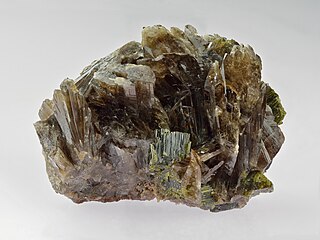
Axinite is a brown to violet-brown, or reddish-brown bladed group of minerals composed of calcium aluminium boro-silicate, (Ca,Fe,Mn)3Al2BO3Si4O12OH. Axinite is pyroelectric and piezoelectric.

Hausmannite is a complex oxide of manganese containing both di- and tri-valent manganese. The formula can be represented as Mn2+Mn3+2O4. It belongs to the spinel group and forms tetragonal crystals. Hausmannite is a brown to black metallic mineral with Mohs hardness of 5.5 and a specific gravity of 4.8.

Lithiophilite is a mineral containing the element lithium. It is lithium manganese(II) phosphate with chemical formula LiMnPO4. It occurs in pegmatites often associated with triphylite, the iron end member in a solid solution series. The mineral with intermediate composition is known as sicklerite and has the chemical formula Li(Mn,Fe)PO4). The name lithiophilite is derived from the Greek philos (φιλός) "friend," as lithiophilite is usually found with lithium.
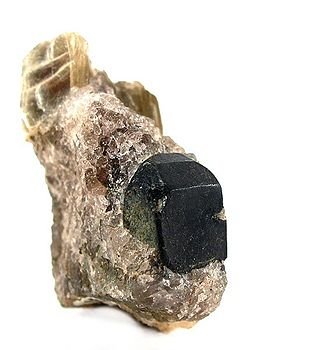
Triphylite is a lithium iron(II) phosphate mineral with the chemical formula LiFePO4. It is a member of the triphylite group and forms a complete solid solution series with the lithium manganese(II) phosphate, lithiophilite. Triphylite crystallizes in the orthorhombic crystal system. It rarely forms prismatic crystals and is more frequently found in hypidiomorphic rock. It is bluish- to greenish-gray in color, but upon alteration becomes brown to black.
Abswurmbachite is a copper manganese silicate mineral ((Cu,Mn2+)Mn3+6O8SiO4). It was first described in 1991 and named after Irmgard Abs-Wurmbach (born 1938), a German mineralogist. It crystallizes in the tetragonal system. Its Mohs scale rating is 6.5 and a specific gravity of 4.96. It has a metallic luster and its color is jet black, with light brown streaks.

Calderite is a mineral in the garnet group with the chemical formula (Mn2+, Ca)3(Fe3+, Al)2(SiO4)3.

Nsutite is a manganese oxide mineral with formula: (Mn4+1−xMn2+xO2-2x(OH)2x where x = 0.06-0.07). It is found in most large manganese deposits and was first discovered in Nsuta, Ghana. Since then, it has been found worldwide. Nsutite is a dull mineral with a hardness of 6.5-8.5 and an average specific gravity of 4.45. Nustite is used as a cathode in zinc–carbon batteries, but synthetic manganese oxide is gradually replacing it.

Triploidite is an uncommon manganese iron phosphate mineral with formula: (Mn, Fe)2PO4OH. It crystallizes in the monoclinic crystal system and typically occurs as elongated and striated slender prisms which may be columnar to fibrous. Its crystals may be pinkish to yellowish brown or red-orange.
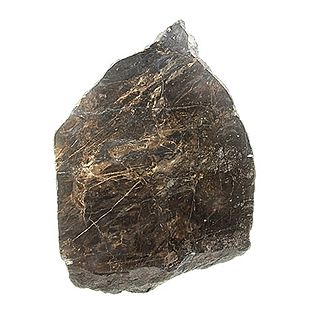
Galaxite, also known as 'mangan-spinel' is an isometric mineral belonging to the spinel group of oxides with the ideal chemical formula Mn2+Al2O4.

Chloritoid is a silicate mineral of metamorphic origin. It is an iron magnesium manganese alumino-silicate hydroxide with formula (Fe, Mg, Mn)
2Al
4Si
2O
10(OH)
4. It occurs as greenish grey to black platy micaceous crystals and foliated masses. Its Mohs hardness is 6.5, unusually high for a platy mineral, and it has a specific gravity of 3.52 to 3.57. It typically occurs in phyllites, schists and marbles.

Jacobsite is a manganese iron oxide mineral. It is in the spinel group and forms a solid solution series with magnetite. The chemical formula is (Mn,Mg)Fe2O4 or with oxidation states and substitutions: (Mn2+,Fe2+,Mg)(Fe3+,Mn3+)2O4.

Neptunite is a silicate mineral with the formula KNa2Li(Fe2+, Mn2+)2Ti2Si8O24. With increasing manganese it forms a series with mangan-neptunite. Watatsumiite is the variety with vanadium replacing the titanium in the formula.

Tapiolite [(Fe, Mn)(Nb, Ta)2O6] is a black mineral series that is an ore of niobium and tantalum. The tapiolite group includes tapiolite-(Fe) or ferrotapiolite and tapiolite-(Mn) or manganotapiolite. Tapiolite-(Fe) is by far the more common of the two.
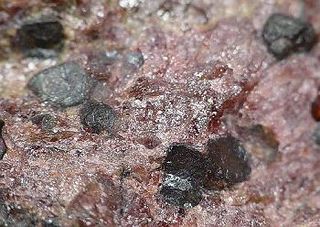
Manganosite is a rare mineral composed of manganese(II) oxide MnO. It was first described in 1817 for an occurrence in the Harz Mountains, Saxony-Anhalt, Germany. It has also been reported from Langban and Nordmark, Sweden and at Franklin Furnace, New Jersey. It also occurs in Japan, Kyrgyzstan and Burkina Faso.
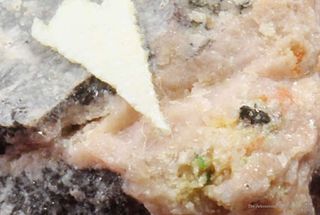
Akrochordite is a rare hydrated arsenate mineral with the chemical formula (Mn,Mg)4(AsO4)2(OH)4·4H2O and represents a small group of rare manganese (Mn) arsenates and, similarly to most other Mn-bearing arsenates, possess pinkish colour. It is typically associated with metamorphic Mn deposits.
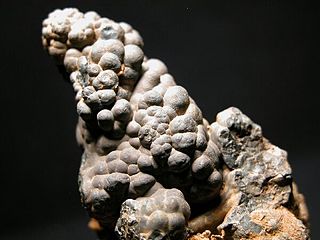
Cryptomelane is a potassium manganese oxide mineral with formula K(Mn4+,Mn2+)8O16.
Gatehouseite is a manganese hydroxy phosphate mineral with formula Mn5(PO4)2(OH)4. First discovered in 1987, it was identified as a new mineral species in 1992 and named for Bryan M. K. C. Gatehouse (born 1932). As of 2012, it is known from only one mine in South Australia.

Hollandite (chemical formula: Ba(Mn4+6Mn3+2)O16) is an oxide mineral. It is the barium-manganese (III) endmember of the coronadite group.

Lamprophyllite is a rare, but widespread mineral Ti-silicate mineral usually found in intrusive agpasitic igneous rocks. Yellow, reddish brown, Vitreous, Pearly.

Strunzite (Mn2+Fe3+2(PO4)2(OH)2{{·}}6H2O) is a light yellow mineral of the strunzite group, first discovered in 1957.


















